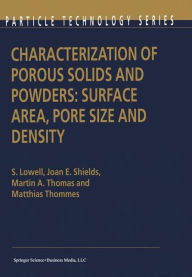
ISBN: 9789048166336
The growth of interest in newly developed porous materials has prompted the writing of this book for those who have the need to make meaningful measurements without the benefit of years o… Meer...
| BarnesandNoble.com new in stock. Verzendingskosten:zzgl. Versandkosten., exclusief verzendingskosten Details... |

Characterization of Porous Solids and Powders: Surface Area, Pore Size and Density (Particle Technology Series) - pocketboek
2010, ISBN: 9048166330
[EAN: 9789048166336], Gebraucht, guter Zustand, [PU: Springer], Like New condition. Great condition, but not exactly fully crisp. The book may have been opened and read, but there are no … Meer...
| AbeBooks.de Book Deals, Tucson, AZ, U.S.A. [85272957] [Rating: 5 (von 5)] NOT NEW BOOK. Verzendingskosten: EUR 19.68 Details... |

Characterization of Porous Solids and Powders: Surface Area, Pore Size and Density (Particle Technology Series) - pocketboek
2010, ISBN: 9048166330
[EAN: 9789048166336], Gebraucht, guter Zustand, [PU: Springer], Buy with confidence! Book is in good condition with minor wear to the pages, binding, and minor marks within, Books
| AbeBooks.de Books Unplugged, Amherst, NY, U.S.A. [74050220] [Rating: 5 (von 5)] NOT NEW BOOK. Verzendingskosten: EUR 46.86 Details... |

Characterization of Porous Solids and Powders: Surface Area, Pore Size and Density (Particle Technology Series, 16) - pocketboek
2010, ISBN: 9048166330
[EAN: 9789048166336], Neubuch, [PU: Springer], Books
| AbeBooks.de Lucky's Textbooks, Dallas, TX, U.S.A. [60577173] [Rating: 5 (von 5)] NEW BOOK. Verzendingskosten: EUR 69.51 Details... |

Characterization of Porous Solids and Powders: Surface Area, Pore Size and Density (Particle Technology Series) - pocketboek
2010, ISBN: 9048166330
[EAN: 9789048166336], Neubuch, [PU: Springer], Books
| AbeBooks.de California Books, Miami, FL, U.S.A. [87239718] [Rating: 5 (von 5)] NEW BOOK. Verzendingskosten: EUR 6.56 Details... |


Characterization of Porous Solids and Powders: Surface Area, Pore Size and Density S. Lowell Author - nieuw boek
ISBN: 9789048166336
The growth of interest in newly developed porous materials has prompted the writing of this book for those who have the need to make meaningful measurements without the benefit of years o… Meer...
Lowell, S.; Shields, Joan E.; Thomas, Martin A.; Thommes, Matthias:
Characterization of Porous Solids and Powders: Surface Area, Pore Size and Density (Particle Technology Series) - pocketboek2010, ISBN: 9048166330
[EAN: 9789048166336], Gebraucht, guter Zustand, [PU: Springer], Like New condition. Great condition, but not exactly fully crisp. The book may have been opened and read, but there are no … Meer...
Characterization of Porous Solids and Powders: Surface Area, Pore Size and Density (Particle Technology Series) - pocketboek
2010
ISBN: 9048166330
[EAN: 9789048166336], Gebraucht, guter Zustand, [PU: Springer], Buy with confidence! Book is in good condition with minor wear to the pages, binding, and minor marks within, Books
Bibliografische gegevens van het best passende boek
| auteur: | |
| Titel: | |
| ISBN: |
Gedetalleerde informatie over het boek. - Characterization of Porous Solids and Powders: Surface Area, Pore Size and Density S. Lowell Author
EAN (ISBN-13): 9789048166336
ISBN (ISBN-10): 9048166330
Gebonden uitgave
pocket book
Verschijningsjaar: 2010
Uitgever: Springer Netherlands Core >1
364 Bladzijden
Gewicht: 0,579 kg
Taal: eng/Englisch
Boek bevindt zich in het datenbestand sinds 2010-04-16T17:35:31+02:00 (Amsterdam)
Detailpagina laatst gewijzigd op 2024-04-26T11:24:09+02:00 (Amsterdam)
ISBN/EAN: 9789048166336
ISBN - alternatieve schrijfwijzen:
90-481-6633-0, 978-90-481-6633-6
alternatieve schrijfwijzen en verwante zoekwoorden:
Auteur van het boek: lowell thomas, joan lowell, thomm, seymour, martin thomas, matthias thömmes
Titel van het boek: area, powder technology, surface series
Gegevens van de uitgever
Auteur: S. Lowell
Titel: Particle Technology Series; Characterization of Porous Solids and Powders: Surface Area, Pore Size and Density
Uitgeverij: Springer; Springer Netherland
350 Bladzijden
Verschijningsjaar: 2010-10-28
Dordrecht; NL
Gedrukt / Gemaakt in
Taal: Engels
252,99 € (DE)
BC; Hardcover, Softcover / Chemie/Physikalische Chemie; Physikalische Chemie; Verstehen; Activation energy; Adsorption Isotherms; Chemisorption; Gas Adsorption; Langmuir and BET Theories; Non-Wetting Liquid Penetration; RSI; nanotechnology; Physical Chemistry; Industrial Chemistry; Industrial and Production Engineering; Analytical Chemistry; Characterization and Analytical Technique; Industrielle Chemie und Chemietechnologie; Fertigungstechnik und Ingenieurwesen; Analytische Chemie; Werkstoffprüfung; BB
1 Theoretical.- 1 Introduction.- 2 Gas Adsorption.- 3 Adsorption Isotherms.- 4 Adsorption Mechanism.- 5 Surface Area from the Langmuir and BET Theories.- 6 Other Surface Area Methods.- 7 Evaluation of the Fractal Dimension by Gas Adsorption.- 8 Mesopore Analysis.- 9 Micropore Analysis.- 10 Mercury Porosimetry: Non-Wetting Liquid Penetration.- 11 Pore Size and Surface Characteristics of Porous Solids by Mercury Porosimetry.- 12 Chemisorption: Site Specific Gas Adsorption.- 2 Experimental.- 13 Physical Adsorption Measurements — Preliminaries.- 14 Vacuum Volumetric Measurements (Manometry).- 15 Dynamic Flow Method.- 16 Volumetric Chemisorption: Catalyst Characterization by Static Methods.- 17 Dynamic Chemisorption: Catalyst Characterization By Flow Techniques.- 18 Mercury Porosimetry: Intra and Inter- Particle Characterization.- 19 Density Measurement.Andere boeken die eventueel grote overeenkomsten met dit boek kunnen hebben:
Laatste soortgelijke boek:
9781402023033 Characterization of Porous Solids and Powders: Surface Area, Pore Size and Density (S. Lowell; Joan E. Shields; Martin A. Thomas; Matthias Thommes)
- 9781402023033 Characterization of Porous Solids and Powders: Surface Area, Pore Size and Density (S. Lowell; Joan E. Shields; Martin A. Thomas; Matthias Thommes)
- 9781402023026 Characterization of Porous Solids and Powders: Surface Area, Pore Size and Density: 16 (Particle Technology Series, 16) (Lowell, S. Shields, Joan E. Thomas, Martin A. Thommes, Matthias)
- Characterization of Porous Solids and Powders: Surface Area, Pore Size and Density (S. Lowell, Joan E. Shields, Matthias Thommes)
< naar Archief...

